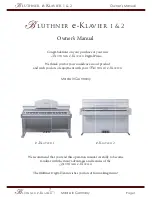
Application Examples – Continued
Page 10
If you are testing a piece of glass that contains more than one laminate inner-layer in a monolithic piece of
glass, then you need to select the MULTI-LAMINATE Mode (see page 3&4). This would include applications
such as bullet resistant glass and fire rated glass. I
The first result screen that appears will show the thickness of all the components comprising the window. This
will include each piece of glass and laminate inner layer. For the laminated glass illustration to the right, the
following result screens would occur. Screen 1 shows the results in Fractions of an inch rounded to the
nearest glass thickness standard. Screen 2 shows the actual thickness of the layers in Fractions of an inch.
Screen 3 shows the Low E results screen. Please note, in Multi-laminate Mode the Low E measurement will
typically only allow for a Low E coating to occur on the 1st surface or the last surface of the multi-laminate
glass assembly. In this application, there is no low e coating on Surface 1, and the last surface is too far away
to be measured by the meter, thus the message that appears.
.
When testing laminated glass, there are applications where the GC3200 meter will not be able to completely
identify the thickness of the laminate inner layer. When this occurs, the meter may still display the overall
thickness of a laminated section that might include a combination of G1 + L1 + G2. When this occurs, the
meter was not able to cleanly identify the laminate inner layer surfaces. Screen 4 below shows an example of
how this will appear. When this condition occurs, the meter will add one additional screen to the rotation of
results screens. The additional screen is called the ASSUMPTION SCREEN. If the user knows that both
pieces of glass in the laminated piece (that are referenced in the ASSUMPTION SCREEN) are the same
thickness, then the meter will show an assumption screen that presumes G1 = G2. If the user knows that G1
= G2, then the meter will confirm the glass thickness, as well as provide an estimate of the laminate inner
layer thickness. If the user does not know for sure that G1 = G2, then the user should disregard the
assumption screen. In the example to the right, G1 does NOT equal G2, so this assumption screen would not
apply to this application. In this instance the user will only know the actual thickness of the first 2 pieces of
glass and laminate inner-layer. NOTE: If the G1/L1/G2 combination continually appears through multiple
measurements on the same glass, the user should attempt a measurement from the other side of the window
if possible. Screen 4 shows a measurement of the same glass example to the right, only the results are
shown in MM and the meter was not able to identify the first laminate inner-layer thickness as described
above. Screen 4 shows the results rounded to the nearest STANDARD glass thickness while Screen 5
shows the resulst in A
t is very important that the laminated glass you are testing
is clean. Because the laminate inner layers are so thin, any dirt or smudges on the glass can negatively
impact the accuracy of the results, or the ability of the meter to detect the laminate inner layer. Please clean
the glass before you take a measurement.
— Measurement Example Seven — Multi-Laminate Glass
1)
3)
4)
2)
5)
LAMINA
TED GL
AS
S 1 (G1 = 1/8” = 3mm)
LAMINA
TED GL
AS
S 3 (G3 = 3/16” = 5mm)
LAMINA
TED GL
AS
S 2 (G2 = 3/16” = 5mm)
LAMINA
TED GL
AS
S 4 (G4 = 1/8” = 3mm)
Glass Surface #
1
5
2
6
3
7
4
8
LAMI Layer
(.030”)


































